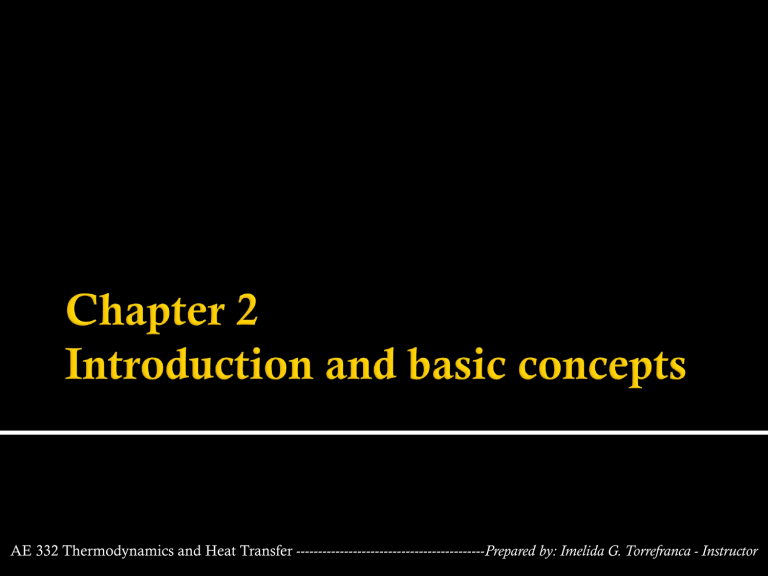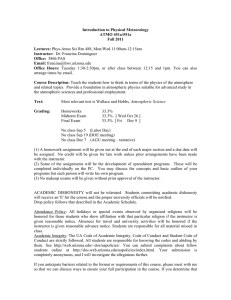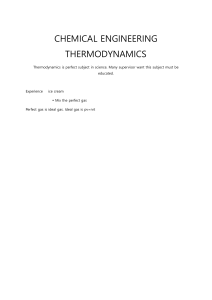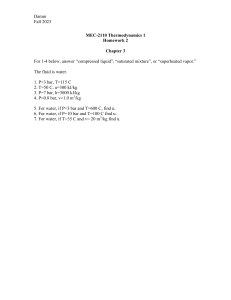
AE 332 Thermodynamics and Heat Transfer -------------------------------------------Prepared by: Imelida G. Torrefranca - Instructor Zeroth Law ▪ Two bodies are in thermal equilibrium if both have the same temperature reading even if they are no in contact. AE 332 Thermodynamics and Heat Transfer -------------------------------------------Prepared by: Imelida G. Torrefranca - Instructor Basis: ▪ Ice point – a mixture of ice and water that is in equilibrium with air saturated with vapor at 1 atm pressure ▪ Steam point – a mixture of liquid water and water vapor (with no air) in equilibrium at 1 atm pressure Celsius scale Fahrenheit scale AE 332 Thermodynamics and Heat Transfer -------------------------------------------Prepared by: Imelida G. Torrefranca - Instructor Formerly called the centigrade scale, renamed after the Swedish astronomer A. Celsius – 1702-1744 Named after the German instrument maker G. Fahrenheit - 1686 - 1736 Celsius scale Fahrenheit scale 100oC Steam points 212oF 0oC Ice points 32oF A scale that is independent of the properties of any substance or substances Kelvin scale, K ( named after Lord Kelvin, 1824-1907) Rankine scale, R (named after William Rankine, 1820 – 1872) T (K) = T (oC) + 273.15 = T (oC) + 273 T (R) = T (oF) + 459.67 = T (oF) + 460 T (R) = 1.8 T (K) T (oF) = 1.8 T (oC) + 32 Temperature differences, ΔT ΔT (K) = ΔT (oC) Δ T (R) = ΔT (oF) AE 332 Thermodynamics and Heat Transfer -------------------------------------------Prepared by: Imelida G. Torrefranca - Instructor Pressure – defined as a normal force exerted by a fluid per unit area Newtons / square meter = Pascal 1 Pa = 1 N/m2 1 kPa = 103 Pa 1 bar = 105 Pa = 0.1 MPa = 100 kPa 1 atm = 101,325 Pa = 101.325 kPa = 1.01325 bars 1 kgf/cm2 = 9.807 N/cm2 = 0.9807 bar = 0.9679 atm AE 332 Thermodynamics and Heat Transfer -------------------------------------------Prepared by: Imelida G. Torrefranca - Instructor Atmospheric pressure (Patm) – pressure due to a column of air Absolute pressure (Pabs)– the actual pressure at a given position, and is measured relative to absolute vacuum (i.e. absolute zero pressure) Gage pressure (Pgage)– difference between the absolute pressure and the local atmospheric pressure Vacuum pressures (Pvac) – pressures below atmospheric pressure AE 332 Thermodynamics and Heat Transfer -------------------------------------------Prepared by: Imelida G. Torrefranca - Instructor AE 332 Thermodynamics and Heat Transfer -------------------------------------------Prepared by: Imelida G. Torrefranca - Instructor Pressure at a point ▪ Pressure is a scalar quantity – it has magnitude but no specific direction ▪ pressure at any point in a fluid is the same in all directions Variation of pressure with depth pressure of a fluid at rest increases with depth (as a result of added weight) pressure in a fluid at rest does not change in the horizontal direction. For gases, the variation of pressure with height is negligible because of their low density Pressure in a fluid at rest is independent of the shape or cross section of the container The pressure is the same at all points on a horizontal plane in a given fluid at rest regardless of geometry, provided that the points are interconnected by the same fluid. The pressure applied to a confined fluid increases the pressure throughout by the same amount The force applied by a fluid is proportional to the surface area Two hydraulic cylinders of different areas could be connected, and the larger could be used to exert a proportionally greater force than that applied to the smaller Example: Ideal mechanical advantage = A2/A1 Hydraulic lift Using a hydraulic car jack with a piston area ratio of A2/A1 100, a person can lift a 1000kg car by applying a force of just 10 kgf ( 90.8 N). AE 332 Thermodynamics and Heat Transfer -------------------------------------------Prepared by: Imelida G. Torrefranca - Instructor The Barometer – measures atmospheric pressure (atmospheric pressure is often referred to as barometric pressure) The Italian Evangelista Torricelli (1608–1647) was the first to conclusively prove that the atmospheric pressure can be measured by inverting a mercuryfilled tube into a mercury container that is open to the atmosphere, as shown. AE 332 Thermodynamics and Heat Transfer -------------------------------------------Prepared by: Imelida G. Torrefranca - Instructor Standard atmosphere ▪ defined as the pressure produced by a column of mercury 760mm in height at 0oC (ρHg = 13,595 kg/m3 at g = 9.807 m/s2) = 10.3 m column of water unit mmHg = unit torr in honor of Torricelli 1 atm = 760 torr 1 torr = 133.3 Pa The atmospheric pressure at a location is simply the weight of the air above that location per unit surface area. Therefore, it changes not only with elevation but also with weather conditions. The decline of atmospheric pressure with elevation has farreaching ramifications in daily life Examples: Cooking takes longer at high altitudes since water boils at a lower temperature at lower atmospheric pressures. Nose bleeding is a common experience at high altitudes since the difference between the blood pressure and the atmospheric pressure is larger in this case, and the delicate walls of veins in the nose are often unable to withstand this extra stress. We tire more easily and experience breathing problems at high altitudes a 2.0-L car engine will act like a 1.7-L car engine at 1500 m altitude (unless it is turbocharged) because of the 15 percent drop in pressure and thus 15 percent drop in the density of air A fan or compressor will displace 15 percent less air at that altitude for the same volume displacement rate The lower pressure and thus lower density also affects lift and drag: airplanes need a longer runway at high altitudes to develop the required lift, and they climb to very high altitudes for cruising for reduced drag and thus better fuel efficiency. The manometer commonly used to measure small and moderate pressure differences. A manometer consists of a glass or plastic U-tube containing one or more fluids such as mercury, water, alcohol, or oil. To keep the size of the manometer to a manageable level, heavy fluids such as mercury are used if large pressure differences are anticipated. Ρ is the density of the fluid in the tube In stacked-up fluid layers, the pressure change across a fluid layer of density ρ and height h is ρgh. Measuring the pressure drop across a flow section or a flow device by a differential manometer AE 332 Thermodynamics and Heat Transfer -------------------------------------------Prepared by: Imelida G. Torrefranca - Instructor A system of fixed mass is called a closed system, or control mass, and a system that involves mass transfer across its boundaries is called an open system, or control volume. The mass-dependent properties of a system are called extensive properties and the others intensive properties. Density is mass per unit volume, and specific volume is volume per unit mass. A system is said to be in thermodynamic equilibrium if it maintains thermal, mechanical, phase, and chemical equilibrium. Any change from one state to another is called a process. A process with identical end states is called a cycle. During a quasi-static or quasi-equilibrium process, the system remains practically in equilibrium at all times. The state of a simple, compressible system is completely specified by two independent, intensive properties. AE 332 Thermodynamics and Heat Transfer -------------------------------------------Prepared by: Imelida G. Torrefranca - Instructor The zeroth law of thermodynamics states that two bodies are in thermal equilibrium if both have the same temperature reading even if they are not in contact. The temperature scales used in the SI and the English system today are the Celsius scale and the Fahrenheit scale, respectively. They are related to absolute temperature scales by AE 332 Thermodynamics and Heat Transfer -------------------------------------------Prepared by: Imelida G. Torrefranca - Instructor The magnitudes of each division of 1 K and 1°C are identical, and so are the magnitudes of each division of 1 R and 1°F. Therefore, AE 332 Thermodynamics and Heat Transfer -------------------------------------------Prepared by: Imelida G. Torrefranca - Instructor The normal force exerted by a fluid per unit area is called pressure, and its unit is the pascal, 1 Pa = 1 N/m2. The pressure relative to absolute vacuum is called the absolute pressure, and the difference between the absolute pressure and the local atmospheric pressure is called the gage pressure. Pressures below atmospheric pressure are called vacuum pressures. The absolute, gage, and vacuum pressures are related by: The pressure at a point in a fluid has the same magnitude in all directions. The variation of pressure with elevation is given by where the positive z direction is taken to be upward. When the density of the fluid is constant, the pressure difference across a fluid layer of thickness Δz is The absolute and gage pressures in a liquid open to the atmosphere at a depth h from the free surface are Small to moderate pressure differences are measured by a manometer. The pressure in a stationary fluid remains constant in the horizontal direction. Pascal’s principle states that the pressure applied to a confined fluid increases the pressure throughout by the same amount. The atmospheric pressure is measured by a barometer and is given by where h is the height of the liquid column. 2-19 The temperature of water changes by 10°F during a process. Express this temperature change in Celcius (°C), Kelvin (K), and Rankine (R) units. A mercury manometer (p = 13,600 kg/m3) is connected to an air duct to measure the pressure inside. The difference in the manometer levels is 15 mm, and the atmospheric pressure is 100 kPa. (a) Judging from the figure below, determine if the pressure in the duct is above or below the atmospheric pressure. (b) Determine the absolute pressure in the duct. Consider a 70-kg woman who has a total foot imprint area of 400 cm2. She wishes to walk on the snow, but the snow cannot withstand pressures greater than 0.5 kPa. Determine the minimum size of the snowshoes needed (imprint area per shoe) to enable her to walk on the snow without sinking.




